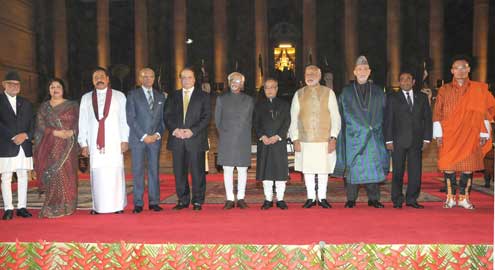2014 was a good year for regional cooperation in South Asia. In May, Indian Prime Minister Narendra Modi’s invitation to the heads of state of the South Asian Association for Regional Cooperation (SAARC) countries to attend his swearing-in ceremony in New Delhi marked a diplomatic first across the region. The image of South Asia’s leaders standing together at a glittering ceremony at the president’s estate was an abiding one, sending a message that India under Modi was ready and open to engaging more proactively with its neighbors.

History tells us that South Asia was once an integrated geographic, social, political, and economic entity. From Afghanistan to Sri Lanka and to Myanmar, there has been a rich tradition and historical legacy of dialogue, intermingling, and exchange. Yet in the decades following their independence, countries in the region have been unable to sustain these ties to engage, cooperate, and do business with one another meaningfully.
Today, South Asia is one of the least integrated regions in the world. Whether it is trade, energy, investment, or jobs, governments in the region have typically done more business outside the region than within. Intra-regional trade as a percentage of total trade in the region has languished at 4-5 percent for over a decade. Efforts at creating an integrated regional bloc through forums such as SAARC have proved unsuccessful, even as efforts at cooperation have been held hostage by geo-politics and on-going intra-regional tensions, especially between neighbors India and Pakistan.
Widely regarded as the “Big Brother” in the region, India has frequently been accused by its neighbors of neglecting the region in favor of more ambitious policy pursuits abroad and, more damningly, of pursuing its own self-interest.
Since independence, bilateralism has been one of the preconditions of India’s engagement in the region. Some argue that this has enabled the state to keep negotiations within its control, limit contestation, and curb third-party opposition from other countries. Given the region’s contentious history, it’s not hard to see why this would be the case, but it’s an approach that has long outlived its relevance. In critical areas such as water, trade, energy, and mobility, India has to start engaging with its neighbors differently. On transboundary water issues for example, while India has signed a number of bilateral treaties with Bangladesh, Nepal, and Pakistan on the Ganges, Brahmaputra, and Indus rivers, it has been unwilling to consider basin or sub-basin level agreements. This has prevented efforts at integrated and basin-wide planning for what is a critical and increasingly scarce resource in the region.
Trade is another area where there is tremendous potential for enhanced cooperation in the region. This is also one area where countries in the region have taken steps toward engagement via regional, sub-regional, and bilateral agreements including the South Asia Free Trade Agreement (SAFTA) and the Bay of Bengal Initiative for Multi-Sectoral Technical and Economic Cooperation (BIMSTEC). However, land, air, sea, telecom connectivity, as well as banking and financial infrastructure, are still poorly developed, and the mobility of goods and people has been restricted through complex customs, visa, and transit regulations.
Improving India’s image and bilateral relations in South Asia has been a policy priority for the Modi government since he was elected in May last year. Tellingly, Modi’s first official foreign visits were to neighbors Bhutan and Nepal where he cemented key agreements on hydropower and energy. The Himalayan countries and the energy they can supply are critical to Modi’s “Make in India” campaign that seeks to position India as a global manufacturing hub. Despite tensions and skirmishes along the border, in September, devastating floods in parts of Indian and Pakistan administered Kashmir, saw both governments extending support torelief and rescue operations. India took steps to enhance defense cooperation with Sri Lanka and the Maldives, committing to provide equipment, training and other supplies. In November, at the 18th SAARC Summit in Kathmandu, Nepal, while countries failed to sign important agreements on rail and road connectivity, the SAARC Framework Agreement for Energy Cooperation was signed – opening the door to electricity trade and cooperation in the region.
At the beginning of each new year, it is customary for many in South Asia to consult horoscopes and crystal-gaze to get a glimpse of what the future holds. So what will 2015 augur for India and its relations with South Asia? We’ve seen important progress over the past year, and South Asia is once again squarely a foreign, political, and economic policy priority for the Indian government. But India will have to do more to demonstrate true leadership in the region, moving away from old-school bilateral approaches to engaging more effectively at a sub-regional, regional, and multi-lateral level. In areas such as trade, energy, investment, and water, there is both a pressing need as well as opportunities for cooperation, benefit-sharing, and mutual gain that are yet to be explored. It’s time that a seemingly rising tide in India worked to raise all ships in the region.
Mandakini Devasher Surie is The Asia Foundation’s senior program officer in India. She can be reached at mandakini.surie@asiafoundation.org. The views and opinions expressed here are those of the individual author and not those of The Asia Foundation.
Source: Asia Foundation







